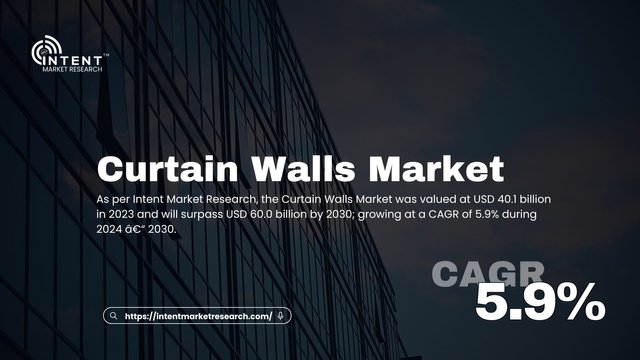Curtain Walls Market: Revolutionizing Architecture with Sustainable Innovations

The curtain walls market is experiencing a period of dynamic growth and evolution, driven by increasing construction activities and a growing focus on sustainable building designs. According to Intent Market Research, the market was valued at USD 40.1 billion in 2023 and is projected to surpass USD 60.0 billion by 2030, growing at an impressive CAGR of 5.9% from 2024 to 2030. Let’s delve deeper into what’s fueling this growth and what it means for the future.
What Are Curtain Walls?
Curtain walls are lightweight, non-structural outer coverings of buildings that are designed to resist weather elements while allowing natural light to enter. Unlike traditional walls, curtain walls are not load-bearing and are typically made of materials like aluminum, glass, and steel. These walls are primarily used in commercial buildings, skyscrapers, and modern architectural projects.
Download Sample Report @ https://intentmarketresearch.com/request-sample/curtain-walls-market-4211.html
Key Factors Driving Market Growth
Urbanization and Infrastructure Development
The rapid pace of urbanization across developing economies is a significant driver. As cities expand, there’s an increased demand for modern commercial spaces and high-rise buildings, where curtain walls play a crucial role.Sustainability Focus
With the construction industry under pressure to reduce carbon footprints, curtain walls have gained traction due to their energy-efficient properties. Many curtain wall systems are designed with double or triple glazing, significantly improving insulation and reducing energy consumption.Aesthetic Appeal and Design Versatility
Curtain walls provide an unmatched aesthetic appeal, enabling architects to create sleek and futuristic designs. Their flexibility in terms of shapes, colors, and materials allows for endless customization, aligning with modern architectural trends.Advancements in Technology
Innovations in materials and construction techniques have enhanced the durability, performance, and installation ease of curtain walls. For instance, smart glass technology is being integrated into curtain wall systems, offering features like automatic tinting to control light and heat.
Market Segmentation
By Material
Glass: Dominates the market due to its aesthetic and functional advantages.
Aluminum: Lightweight and corrosion-resistant, widely used in frameworks.
Steel: Provides extra strength for large-scale structures.
By Application
Commercial Buildings: Includes office spaces, malls, and hotels.
Residential Buildings: High-end apartments and luxury residences.
Industrial Structures: Warehouses and factories with modern designs.
By Region
North America: A leader due to established infrastructure and advanced technologies.
Asia-Pacific: The fastest-growing region, driven by urbanization in China and India.
Europe: Focuses on energy-efficient and sustainable constructions.
Emerging Trends in the Curtain Walls Market
Green Building Initiatives
Governments worldwide are promoting eco-friendly construction, propelling the adoption of curtain walls with thermal insulation and low-emission properties.Integration of Smart Features
Curtain walls are evolving with smart technologies, such as sensors for energy management, self-cleaning glass, and integrated solar panels.Prefabrication
The use of prefabricated curtain wall systems is increasing as it reduces installation time and labor costs while ensuring precision.Lightweight Materials
Innovations in composite materials have led to lighter yet stronger curtain wall systems, reducing overall building load.
Access Full Report @ https://intentmarketresearch.com/latest-reports/curtain-walls-market-4211.html
Challenges in the Market
While the outlook is positive, the market does face challenges:
High Initial Costs: Curtain walls require significant upfront investment, which can deter smaller projects.
Maintenance Issues: Regular upkeep is essential to maintain their functionality and appearance.
Environmental Concerns: Glass curtain walls can contribute to heat islands if not designed with proper shading or energy-efficient glass.
Future Outlook
The future of the curtain walls market looks promising, with rapid advancements in materials, design, and energy efficiency. The integration of technologies like AI and IoT in building systems further elevates the role of curtain walls in modern architecture.
As urbanization accelerates and sustainability becomes a cornerstone of construction, curtain walls will likely remain at the forefront of architectural innovation.
FAQs
What is the primary function of a curtain wall?
A curtain wall is designed to protect buildings from external weather elements, enhance aesthetics, and allow natural light to enter without being load-bearing.Why are curtain walls popular in commercial buildings?
Curtain walls provide a sleek, modern appearance, improve energy efficiency, and allow for flexible design, making them ideal for commercial applications.How does sustainability impact the curtain walls market?
Sustainability drives the demand for energy-efficient curtain wall systems, particularly those with advanced glazing and insulation technologies.What materials are commonly used in curtain walls?
Glass, aluminum, and steel are the most commonly used materials due to their strength, durability, and aesthetic appeal.What challenges does the curtain walls market face?
High initial costs, maintenance requirements, and environmental concerns are some of the key challenges.
About Us
Intent Market Research (IMR) is dedicated to delivering distinctive market insights, focusing on the sustainable and inclusive growth of our clients. We provide in-depth market research reports and consulting services, empowering businesses to make informed, data-driven decisions.
Our market intelligence reports are grounded in factual and relevant insights across various industries, including chemicals & materials, healthcare, food & beverage, automotive & transportation, energy & power, packaging, industrial equipment, building & construction, aerospace & defense, and semiconductor & electronics, among others.
We adopt a highly collaborative approach, partnering closely with clients to drive transformative changes that benefit all stakeholders. With a strong commitment to innovation, we aim to help businesses expand, build sustainable advantages, and create meaningful, positive impacts.
Contact Us
US: +1 463-583-2713